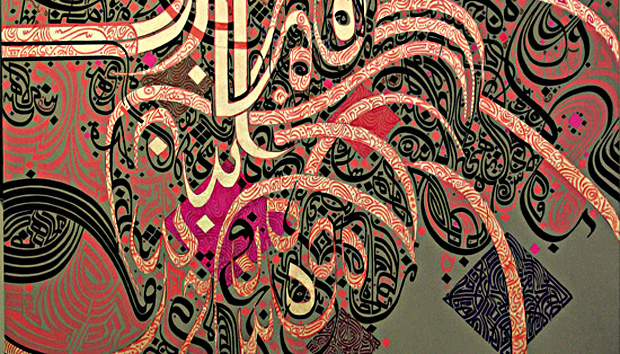

As a feature of the Doha Capital of Arab Culture 2010 celebrations, the internationally renowned Sotheby’s house organized the first auction in the world especially set-up for the art of Arabic calligraphy titled “Hurouf: The Art of the Word”. Indeed, in addition to Arabic calligraphy being a product of intellectual and creative expression for the local culture, it is similarly found at the core of Islamic culture. Allah Almighty said: “Read! Your Lord is the Most Bountiful One who taught by means of the pen, who taught man what he did not know” The sale includes 145 pieces showcasing the works of 65 artists from 24 countries. 82 of those pieces are contemporary, and Qatar participates through two of its artists: Yousef Ahmad and Ali Hassan.
Khaleejesque attended the press conference that was held prior to the auction. Mr. Robin Woodhead – Chairman, Sotheby’s International and Director, Sotheby’s Inc. started his speech saying “2010 has been both exciting and important for the arts. Doha is in fact a capital of Arab culture and Qatar has been chosen to host the World Cup for the year 2022. We could not have chosen a better time to present the first auction dedicated to the art of calligraphy that extends over 1,400 years.”
Then Mr. Edward Gibbs – Director and Head of the Middle East and India department at Sotheby’s guided us on a tour to familiarize us with offered pieces that were dated back to the eighth and ninth centuries including Kufic works of Quranic verses, Eastern Iranian Kufic style and Moroccan Kufic style from the west. He also displayed works by contemporary Muslim calligraphers who honored their earlier masters with emulating the traditional styles while infusing their creations with a bit of their modern spirit.
Following that, Mr. Benedict – Specialist at Sotheby’s took over the tour. He holds a Masters Degree in Middle Eastern Studies, he learned to speak Arabic in Jordan and Alexandria and he amassed tremendous experience in Islamic art. He presented the works of artists such as Hamid Aytac, and he introduced us to works done in the Ottoman era which extends between the epoch of the earliest calligraphy masters and the time of twentieth century artists. Among the striking works is a piece by Abd Al-Qadir that consists of one piece of paper that is so intricately cut out with great detail to form a religious inscription.
Then Ms. Dalya Islam – Deputy Director, ME Department joined in. She is knowledgeable in contemporary Arabic, Turkish and Iranian art. She explained that modern calligraphers were influenced by impressionist artists and started adopting an abstract-oriented line, such as using their pen stroke to accommodate their varied compositions. This is known as calligraphic movement “Al-Haraka Al-Huroufiya”, which doesn’t stop at the beauty of the letter; it extends to the meaning as well. While the tools of modern line drawing became diverse, such as using neon lights for example, the diversity of the national origins of calligraphers also became pronounced. Aside from Arabs, there are Japanese and Chinese calligraphers. She also turned the spotlight on the Pakistani artist Sadequain who stirred a revolution in his country where many do not understand the Arabic language. He started representing Quranic verses as if they were drawings so everybody could understand the meaning.
The Qatari artist Ali Hassan participated with a number of paintings, and his heavy use of the letter “N” ‘Noon’ was quite noticeable. He explained that this letter displays the strength of the Arabic written line with all its beauty and versatility. He has been using it all along for approximately 22 years.
Among the exceptional works displayed is the external curtain of the Holy Ka’ba which was made of silk and silver threads and which dates back to the middle of the nineteenth century. It is valued at USD 300,000. There is also a piece that reflects a modern interpretation of the traditional line by the calligrapher Mounir Fatmi, and it is valued at USD 70,000. The auction also includes two works by the world-renowned Egyptian Calligrapher Dr. Ahmed Moustafa. One of them is titled “The Night Journey and Ascension” “ Al-Israa wal Miraj”, and it was sold for USD 842,500. It resembles a moving angelic festival that carries the letters at an increasing speed towards heaven. And when the question of what determines the material value of a work of art was asked, the answer was that “time is the true appraiser for the artist, and the true artist is one who has awareness that time will grant him or her a valued position sooner or later. A guiding example is Rembrandt who was rebuffed by the Dutch and he didn’t pay attention to them. But today Holland celebrates his works by displaying them in its greatest museums.”
As they say, a picture is worth a thousand words. So I leave you with this selected collection:









By: Fahad Al-Maawda







